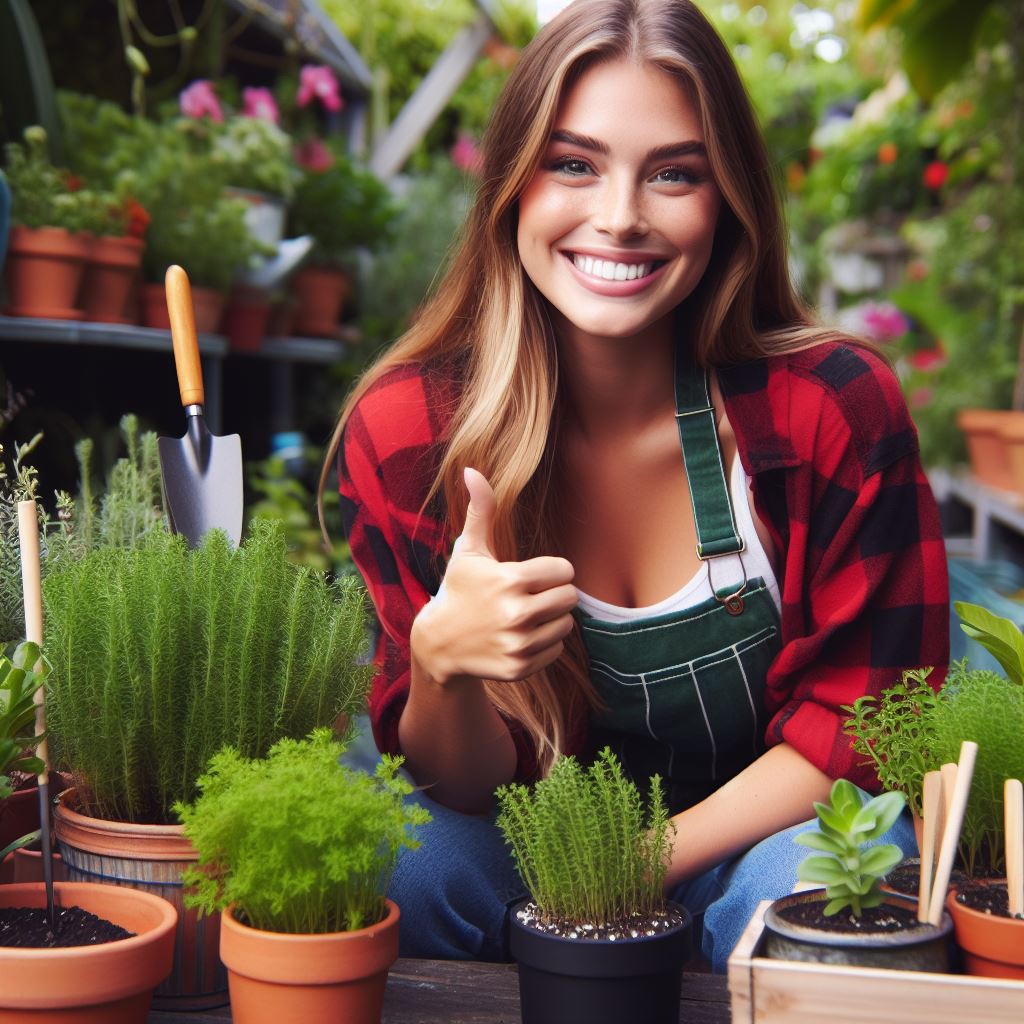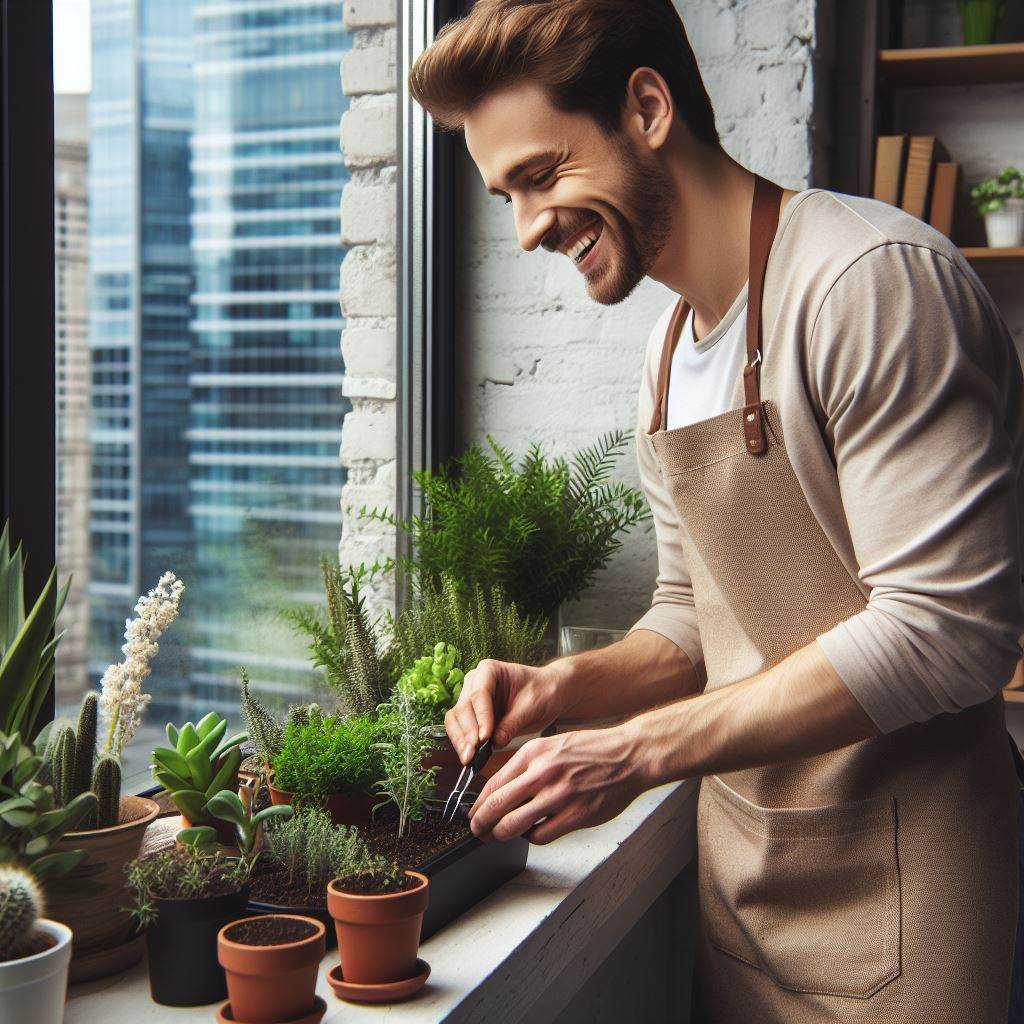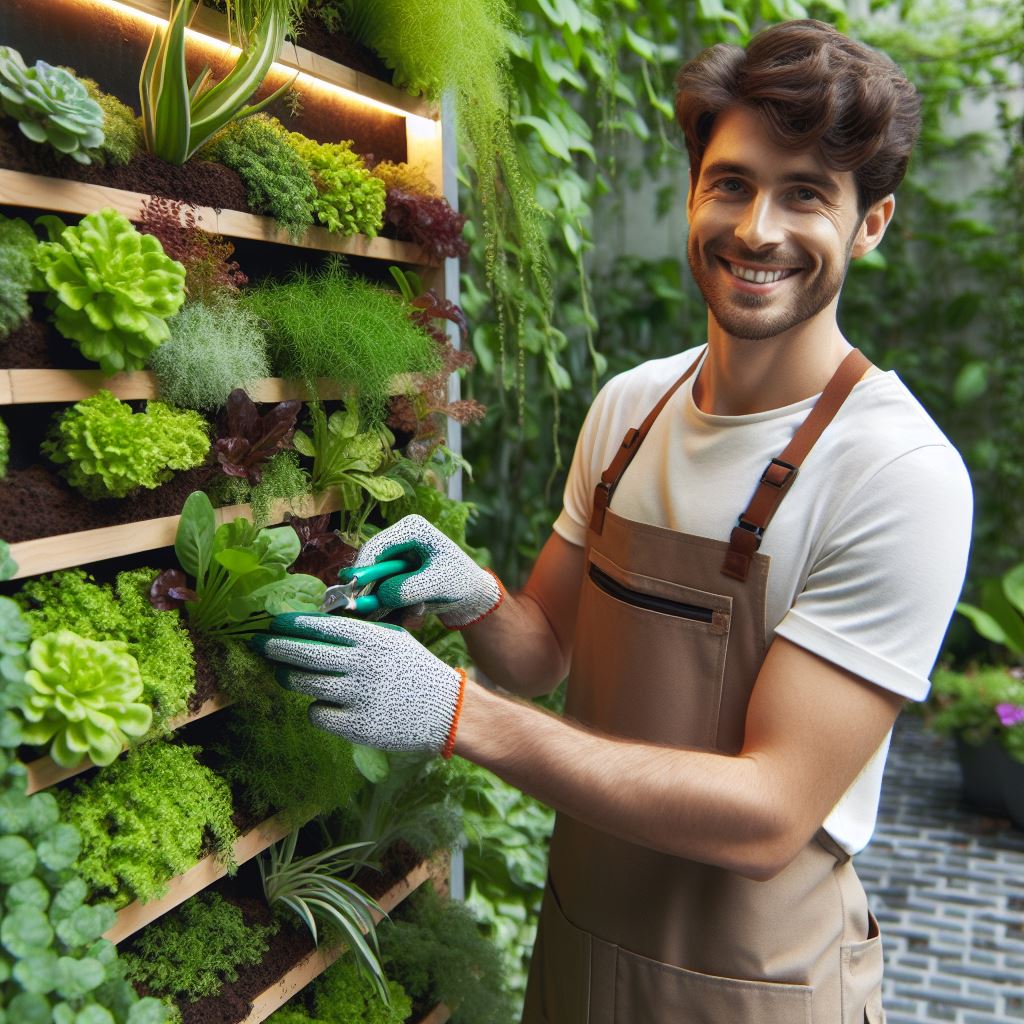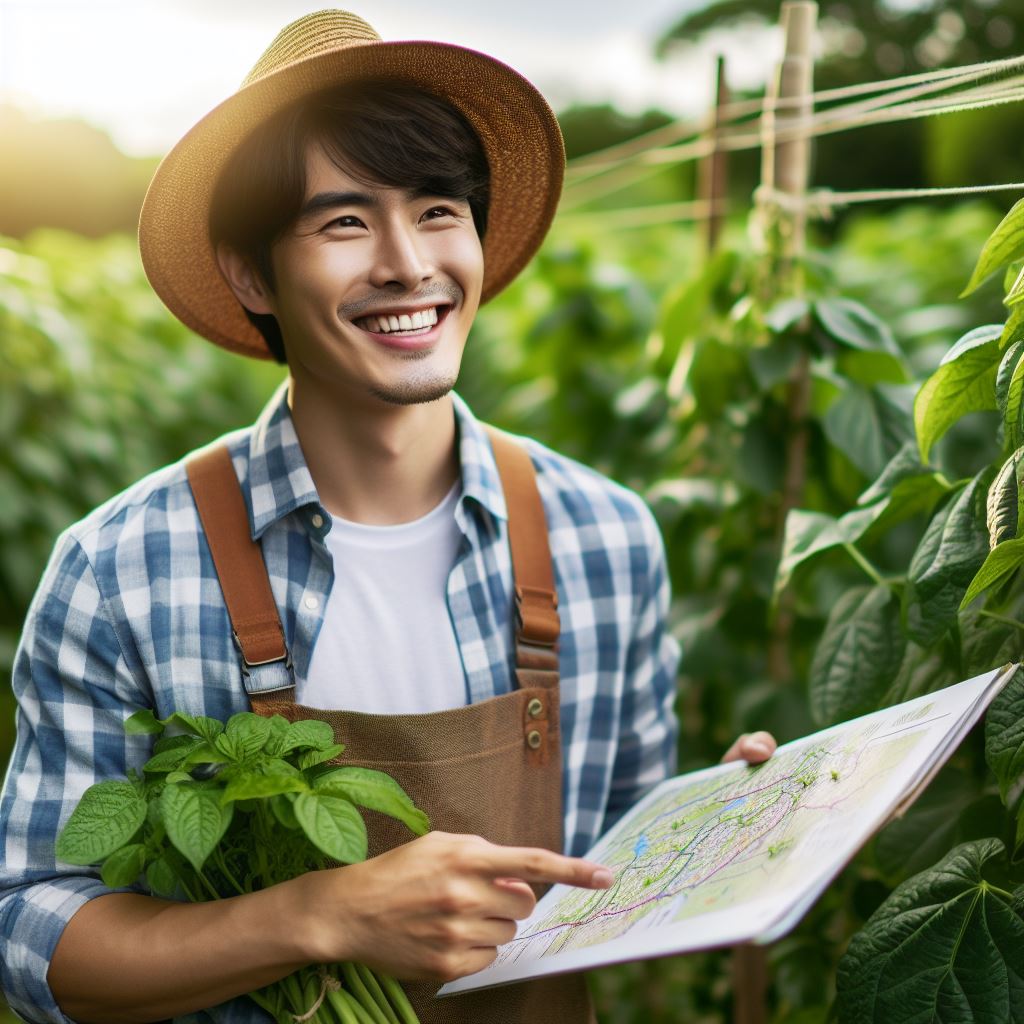Introduction
Embark on a journey into the world of container gardening, a dynamic and space-efficient approach to cultivating herbs.
With urban spaces becoming more compact, container gardening emerges as a crucial method to infuse greenery into our lives.
Elevate your living environment by seamlessly integrating herbs into your daily surroundings, creating not just a garden but a Herb Haven.
Overview of the Blog Post Content
Unlock the secrets to successful herb container gardening with this comprehensive guide.
We will delve into essential tips, starting from selecting the right containers that match your aesthetic preferences and space constraints.
Explore the nuances of choosing the perfect soil mix to ensure optimal growth and health for your herbs.
Additionally, we’ll shed light on space-saving techniques that make container gardening accessible to everyone.
Lastly, discover the ideal herbs for container growth, each bringing its unique flavor and fragrance to your Herb Haven.
Join us on this green adventure, as we guide you through the art and science of cultivating a thriving herb container garden.
Benefits of Container Gardening
Container gardening offers numerous advantages, making it an ideal choice for those with limited space, a need for flexibility, and a desire for low-maintenance plants.
Whether you live in a small apartment or a bustling urban area, container gardening can transform your living space and provide a sense of satisfaction and fulfillment.
No Need for a Large Space
One of the primary benefits of container gardening is that it eliminates the need for a large yard or garden.
Even if you only have a small balcony or windowsill, you can still grow a wide variety of plants.
Containers come in all sizes, allowing you to make the most of your available space.
Having a small living space should never limit your ability to enjoy the beauty and benefits of gardening.
A few pots or planters strategically placed can create a lush oasis in even the tiniest of areas.
Flexibility to Move Plants as Needed
Container gardening offers the convenience of mobility.
With pots and planters, you have the freedom to move your plants around as necessary.
This flexibility is especially valuable when dealing with plants that have specific light or temperature requirements.
For example, if you notice that a particular pot of herbs is not getting enough sunlight on your balcony, you can easily relocate it to a sunnier spot.
Likewise, if a sudden cold snap is on the horizon, you can bring your vulnerable plants indoors for protection.
Easy to Maintain and Care For
Container gardening is known for being low-maintenance.
Compared to traditional gardens, potted plants require less weeding, watering, and fertilizing.
Containers also prevent the spread of invasive plants and reduce the risk of disease and pests.
In addition, containerized plants are less likely to develop issues like root rot or nutrient deficiencies.
With proper drainage and appropriate soil mix, you can provide your plants with the optimal growing conditions, ensuring their health and vitality.
Excellent Option for Urban Dwellers
For people living in urban areas, container gardening is a fantastic solution.
Many city dwellers lack access to open spaces or have to contend with contaminated soil.
Containers offer a safe and controlled environment to grow plants without the worry of contaminants.
Urban gardeners can enjoy fresh herbs, vegetables, and flowers right on their balconies or rooftops.
Container gardening fosters a connection with nature and provides a much-needed respite from the concrete jungle, enhancing the quality of life in bustling cities.
Overall, the benefits of container gardening are vast.
It allows you to have a beautiful and productive garden regardless of your living situation.
With a little creativity and the right containers, you can create your very own herb haven, bringing the joy of gardening into your everyday life.
Selecting Containers
Choosing the right size for each plant
When it comes to container gardening, selecting the right size of containers for your plants is crucial.
The size of the container will directly affect the growth and health of your plants.
- Consider the mature size of the plant: Before selecting a container, it is important to know the mature size of the plant you want to grow. This will help you determine the appropriate size of the container.
- Provide enough room for root growth: Plants need space for their roots to expand and absorb nutrients. A container that is too small can restrict root growth and lead to stunted or unhealthy plants. Choose a container that allows for ample root space.
- Avoid overcrowding: It is essential to provide each plant with enough space to grow and thrive. Crowded containers can lead to competition for resources, increased susceptibility to diseases, and poor air circulation. Choose containers that can comfortably accommodate each plant without overcrowding them.
Materials and durability considerations
The selection of container materials greatly impacts the longevity and functionality of your container garden.
Consider the following materials and durability factors before making a choice:
- Plastic containers: Lightweight and affordable, plastic containers are a popular choice for container gardening. They are durable, resistant to cracks, and retain moisture well. However, plastic may deteriorate under direct sunlight over time.
- Ceramic and clay containers: These containers are known for their aesthetic appeal. They provide good drainage and breathability for plant roots. However, they can be fragile and may require proper insulation during cold weather to prevent cracking.
- Wooden containers: Made from various types of wood, such as cedar or redwood, wooden containers offer a natural and rustic look. They provide good insulation for plant roots but can rot over time. Ensure the wood is treated to increase longevity.
Drainage requirements
Proper drainage is crucial for container gardening as it prevents waterlogging and the development of root rot.
Consider the following drainage requirements for your containers:
Transform Your Agribusiness
Unlock your farm's potential with expert advice tailored to your needs. Get actionable steps that drive real results.
Get Started- Drainage holes: Look for containers with drainage holes at the bottom. These allow excess water to escape, preventing waterlogged soil. If your chosen container lacks drainage holes, consider drilling or creating openings.
- Saucers or trays: Placing a saucer or tray beneath the container can collect excess water, preventing it from pooling and potentially damaging your floors or balcony. Make sure the saucer does not hold standing water for too long.
- Soil mix: Good drainage also depends on the soil mix used. Use a well-draining potting mix that consists of a combination of organic matter and coarse materials like perlite or vermiculite. This will ensure adequate drainage for your plants.
In fact, selecting the right containers for your container garden is essential for the successful growth and development of your plants.
Consider the right size, materials, durability, and drainage requirements to create a healthy and thriving garden.
Soil and Plant Selection
Quality of soil for container gardening
- Use well-draining soil that is rich in organic matter for container gardening.
- Avoid using soil from your garden as it may contain pests or diseases.
- Look for soil mixes specifically labeled for container gardening at your local garden center.
- Consider adding compost or perlite to improve the soil’s drainage and moisture-holding capacity.
Choosing appropriate plants for container gardening
- Select plants that are suitable for growing in containers, such as herbs, vegetables, or flowers.
- Focus on herbs that thrive in containers, such as basil, rosemary, thyme, and parsley.
- Research the specific growing requirements of each plant to ensure it will thrive in a container environment.
- Consider the mature size of the plants and choose ones that won’t outgrow your containers too quickly.
Herbs that thrive in containers
- Basil: This aromatic herb is easy to grow in containers and adds flavor to various dishes.
- Rosemary: A woody perennial herb that requires well-draining soil and plenty of sunlight.
- Thyme: This versatile herb prefers drier soil and can be grown in a small container.
- Parsley: A biennial herb that grows well in containers and adds freshness to many recipes.
Tips for selecting herb varieties
- Consider the purpose of growing herbs, whether it’s for cooking, medicinal, or ornamental use.
- Choose compact varieties of herbs that are better suited for container gardening.
- Look for disease-resistant varieties to minimize the risk of plant problems in your containers.
- Experiment with different herb combinations to create interesting and diverse container gardens.
In short, the quality of soil and the selection of appropriate plants are crucial for successful container gardening.
Using well-draining soil and choosing plants that are suitable for containers, particularly herbs, ensures a thriving and productive garden.
By considering factors such as the soil quality, plant varieties, and their specific requirements, you can create a beautiful and functional container garden that brings joy and adds flavor to your life.
Read: Hydroponics: Gardening Without Soil
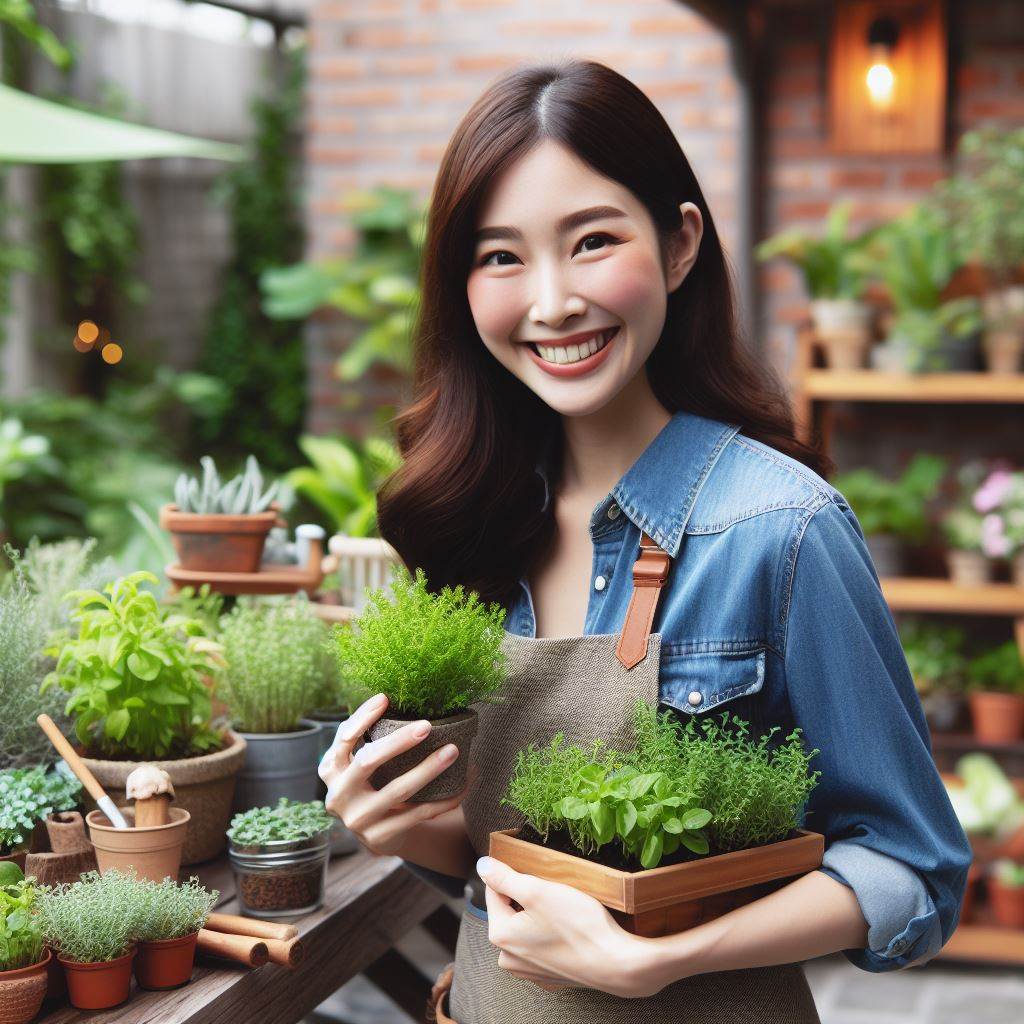
Planting and Placement
Proper planting techniques in containers
- Choose the right size container to allow proper root development and growth.
- Fill the container with well-draining potting soil, leaving some space at the top.
- Place the plant in the center of the container, ensuring it is upright and at the same depth as in its original pot.
- Gently pat down the soil around the plant, making sure it is firmly planted.
- Water the container thoroughly to settle the soil and eliminate air pockets.
Creating a suitable environment for plant growth
Sunlight requirements
- Consider the light requirements of each plant and place containers accordingly.
- Ensure plants receive the appropriate amount of sunlight each day for optimal growth.
- Choose a location where plants receive at least 6-8 hours of direct sunlight.
Watering needs
- Monitor the moisture level of the soil regularly and water plants as needed.
- Avoid overwatering or underwatering, as both can be detrimental to plant health.
- Feel the soil with your finger, and if it feels dry, water the container thoroughly.
Temperature considerations
- Different plants have different temperature preferences, so choose plants suitable for your climate.
- Understand the temperature requirements of each plant and place containers accordingly.
- Provide protection for plants during extreme temperatures, such as using shade cloths or bringing them indoors.
By following proper planting techniques in containers, you can create a thriving garden in even the smallest spaces.
Choosing the right size container allows for proper root development and ensures healthy plant growth.
Filling the container with well-draining potting soil provides the necessary nutrients and helps prevent waterlogged roots.
When placing plants in containers, it is crucial to consider their sunlight requirements.
Placing containers in areas that receive adequate sunlight ensures that plants can photosynthesize properly and thrive.
Additionally, monitoring the moisture level of the soil and watering plants accordingly is essential for their well-being.
Overwatering or underwatering can lead to root rot or dehydration, respectively.
Temperature considerations are also important when it comes to plant growth.
Different plants have different temperature preferences, so it is vital to choose plants suitable for your climate.
Some plants thrive in hotter temperatures, while others prefer cooler conditions.
Providing protection during extreme temperatures, such as frost or heatwaves, can help prevent damage to the plants.
Creating a suitable environment for your container garden is essential for the health and growth of your plants.
By understanding and fulfilling their sunlight, watering, and temperature needs, you can ensure a beautiful and thriving container garden.
Remember to regularly monitor the soil moisture, water appropriately, and provide suitable protection during extreme weather conditions.
With proper planting and placement, your container garden will become a haven of herbs.
Read: Apartment Aquaponics: Fish & Plants
Maintenance and Care
Maintaining and caring for your container garden is crucial to ensure the health and productivity of your herbs.
By following these essential practices, you can enjoy a thriving herb haven right at your fingertips.
Regular watering and fertilizing
To keep your container plants hydrated, water them regularly, making sure the soil is consistently moist but not waterlogged.
A good rule of thumb is to water when the top inch of soil feels dry.
Additionally, fertilizing your herbs every two weeks with a water-soluble fertilizer will provide them with the necessary nutrients for healthy growth.
Adjust the frequency and amount of watering and fertilizing based on the specific needs of each herb, as some may require more or less moisture and nutrients.
Controlling pests and diseases in containers
Regular monitoring of your container plants is essential to catch any signs of pests or diseases early on.
Take the time to inspect your herbs carefully, checking both the leaves and stems for any abnormalities.
If you notice any signs of infestation or disease, such as chewed leaves or brown spots, immediately remove the affected leaves or plants to prevent further spread.
Instead of using harmful chemicals, opt for organic insecticides or natural remedies to control pests.
Providing proper air circulation by spacing out your containers can help minimize the risk of diseases, as some fungal infections thrive in humid and stagnant environments.
Pruning and harvesting techniques
Pruning your herb plants is essential to encourage new growth and maintain the desired shape.
Regularly remove any dead or damaged leaves to prevent the spread of diseases among your container garden.
When harvesting your herbs, it’s best to do so frequently to promote continuous growth and ensure the best flavor.
Use sharp, clean shears or scissors to avoid damaging the plants.
Harvesting the herbs also prevents them from becoming overgrown and encourages bushier and more productive plants.
In essence, maintaining and caring for your container garden is vital for the success of your herb haven.
By implementing regular watering and fertilizing routines, controlling pests and diseases, and utilizing proper pruning and harvesting techniques, you can enjoy a flourishing and bountiful herb garden all year long.
Read: DIY Urban Greenhouse: Step-by-Step
Advantages of Container Gardening over Traditional Gardens
Container gardening offers several advantages over traditional gardens.
By utilizing containers, you can enjoy the following benefits:
Less exposure to invasive weeds
- Containers provide a barrier between the soil and the surrounding environment.
- This significantly reduces the risk of invasive weeds entering your garden.
- With container gardening, you won’t have to spend hours pulling out invasive weeds.
- It makes maintenance and weed control tasks much more manageable and less time-consuming.
Easier to control soil quality and nutrient content
- Container gardening allows for greater control over the soil used in your garden.
- You can customize the soil and nutrient content specific to the needs of each plant.
- This ensures optimal growth and abundant harvests.
- You can add compost, fertilizer, and other supplements to meet the unique requirements of your plants.
- In traditional gardens, the soil quality may vary across the garden, making it harder to grow certain plants successfully.
Portability and ability to protect plants from harsh weather conditions
- One of the key advantages of container gardening is the ability to move plants.
- If harsh weather conditions such as frost or heavy rain are expected, you can bring your plants indoors.
- Containers can be easily relocated to spots with optimal sunlight or shade.
- You have greater control over the plants’ exposure to the elements.
- In traditional gardens, protecting plants from extreme weather can be more challenging.
- Transplanting plants or building protective structures can be labor-intensive and time-consuming.
In review, container gardening provides distinct advantages over traditional gardens.
The reduced exposure to invasive weeds, ability to control soil quality, and nutrient content offer better growth conditions for your plants.
Additionally, the portability of containers allows for protection against harsh weather conditions, ensuring your plants thrive in any environment.
Whether you have limited space or simply desire more flexibility and convenience, container gardening is an excellent choice for all gardening enthusiasts.
Read: Urban Chicken Coops: Fresh Eggs Daily
Troubleshooting Common Container Gardening Issues
In container gardening, like any other type of gardening, you may come across certain issues that can hinder the growth and health of your herbs.
Here, we will discuss some of the most common problems you may encounter and how to solve them:
Overwatering and drainage problems
- Overwatering can drown the roots of your herbs and cause rotting. Avoid excessive watering.
- Ensure that your containers have proper drainage holes to prevent waterlogged soil.
- Check the moisture level of the soil regularly by sticking your finger an inch deep into it.
- Adjust your watering routine according to the specific needs of the herbs you are growing.
Nutrient deficiencies and excesses
- Monitor the nutrient levels in the soil by conducting regular soil tests.
- Identify nutrient deficiencies by observing the appearance of your herbs’ leaves.
- Provide balanced fertilizers or organic compost to replenish nutrients in the soil.
- Avoid over-fertilizing, as it can lead to nutrient excesses and harm your herbs.
Dealing with pests and diseases in containers
- Inspect your herbs regularly for any signs of pests or diseases, such as yellow spots or holes in leaves.
- Remove any affected leaves or plants to prevent the spread of pests and diseases.
- Use organic insecticidal soaps or neem oil sprays to control common pests like aphids and mites.
- Introduce beneficial insects like ladybugs or lacewings to maintain a balanced ecosystem in your container garden.
- Prevent diseases by ensuring good air circulation around your containers and avoiding overcrowding.
- Practice crop rotation by changing the location of your containers each planting season to reduce disease incidence.
By being aware of these common issues and applying the appropriate solutions, you can ensure a thriving container garden full of healthy and flavorful herbs.
Troubleshooting problems promptly will help you maintain a beautiful and productive herb haven.
You Might Also Like: Soil Health in Small Spaces: Key Tips
Conclusion
Recap of the benefits and essentials of container gardening
Container gardening offers numerous benefits, making it an ideal option for people with limited space or mobility issues.
It allows individuals to grow plants and herbs in a small area, such as a balcony, patio, or even a window sill.
By using containers, gardeners have greater control over soil quality, watering, and pest control.
Additionally, container gardens are easily adjustable, allowing for easy rearrangement and experimentation with various plant combinations.
This flexibility also enables gardeners to create customized herb havens that suit their preferences and needs.
Encouragement to start a herb haven using containers
If you’ve been contemplating starting a garden but don’t have a large outdoor space, container gardening is the perfect solution.
Begin by choosing a few of your favorite herbs and finding suitable containers.
Remember to select pots with proper drainage holes and use high-quality potting soil to ensure healthy plant growth.
Place your containers in an area that receives sufficient sunlight and water them regularly.
Don’t forget to fertilize and prune your herbs when necessary.
With a little care and attention, you’ll soon have a thriving herb haven that provides you with fresh, flavorful additions to your culinary endeavors.
So don’t wait any longer, start container gardening today and enjoy the rewards of your own herb haven!

